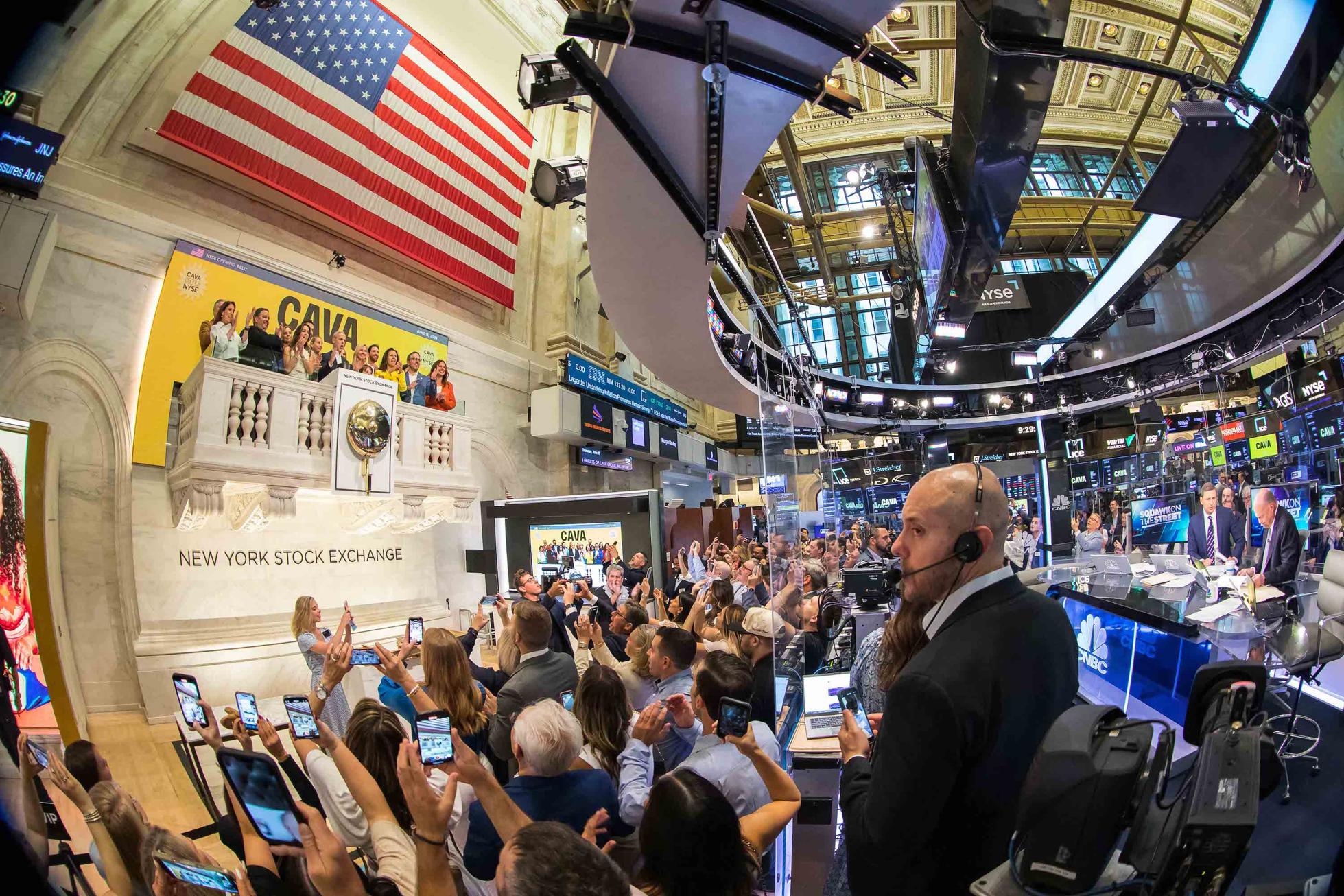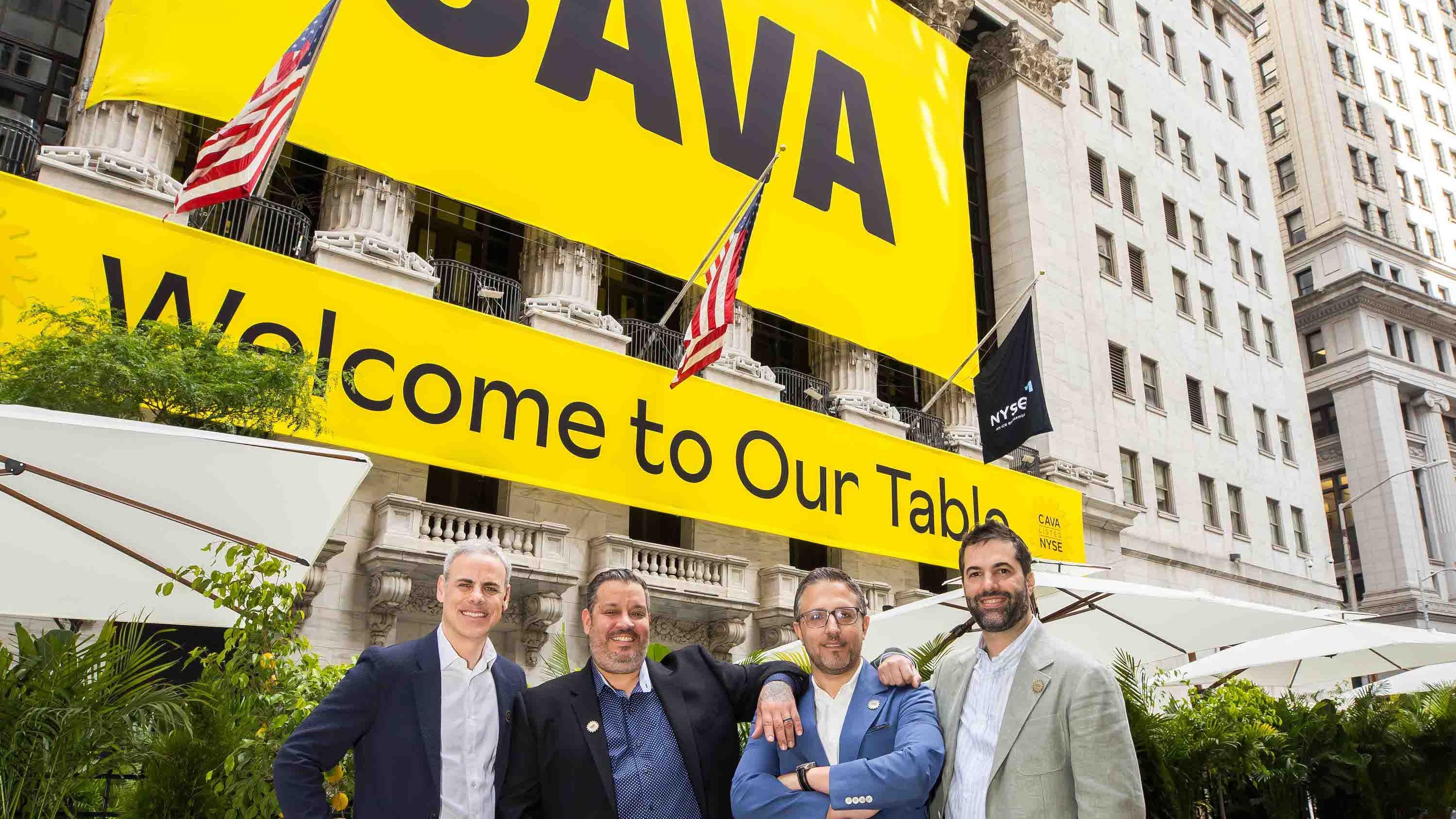Mediterranean restaurant chain Cava surged to a market value of $4 billion after a highly anticipated initial public offering on Thursday.
The New York Stock Exchange debut raised $318 million for the fast-casual brand, valued at the start of the day’s trading at $2.45 billion. Cava sold some 14 million shares — a bright spot in a tepid public market that has minted few new restaurant or food deals.
“This is not the destination,” Cava CEO Brett Schulman, 51, told Forbes just after the listing. “It’s the beginning of the next chapter of our journey. We’ve tried to operate for the last few years like a public company even though we were a private company.”
Schulman says the “incredibly well-received” listing is due to “the significant white-space opportunity” of “defining the Mediterranean category.”
“There was significant demand from all types of investors — because they see the rare opportunity to have a category-defining brand,” Schulman said.
Shares under the ticker CAVA began trading at $22 and nearly doubled to $42 per share by 1 p.m. New York time.
The chain that sells falafel, gyro and shawarma-inspired bowls and pita sandwiches got its start in 2006 when the three original cofounders — Ike Grigoropoulos, Chef Dimitri Moshovitis, and Ted Xenohristos — decided to bring their family’s food to the masses with a brand called Cava Mezze. The trio have known each other since they were six years old, when they attended their Greek Orthodox church’s Sunday School class together.
It all came together when Schulman, a former investment banker who had also been chief operating officer of a nationally distributed snack brand, joined as the CEO and fourth cofounder in 2010. The first location opened in Bethesda, Maryland in 2011. From there, the Washington, D.C.-based Cava quickly became one of the fastest-growing restaurant chains in the U.S., opening a dozen or so locations a year. In 2018, Cava acquired failing chain Zoe’s Kitchen for $300 million. After taking the firm private, Cava converted its 145 locations into more Cava stores, in addition to 51 more that they’ve since opened from scratch.
Last year, revenue rose 12% to $564 million, while the company reported a net loss of $59 million after losing $37 million in 2021. The unprofitable firm now has more than 260 restaurants across D.C. and 22 states. Before the IPO, Cava had raised a total of about $650 million, including a $230 million Series F led by T. Rowe Price in 2021 that valued the chain at $1.7 billion.
The New York Stock Exchange welcomes executives from CAVA.
NYSE
According to Cava’s public filings, Schulman has the biggest stake of any of the cofounders. He owns 2.2% of the firm’s shares, or more than 2 million shares, worth $44 million at listing price. The only other cofounder to retain a significant amount of shares is Xenohristos, 44, who has served as Cava’s chief concept officer since November 2020 and as a board member since 2010. He owns roughly 0.5% of total shares, worth $12 million.
“It’s a pretty surreal moment,” said Xenohristos, who got his start in the restaurant business while attending shifts with his mother, an immigrant from Cyprus, who was a waitress. “We started this to share a lot of the food that our parents made for us. Cava gave us the opportunity.”
Brett Schulman, Chief Executive Officer and cofounder is joined by Lynn Martin, NYSE President and Cava cofounder Ted Xenohristos.
NYSE
Buzz has helped make Cava the biggest restaurant listing in two years. Its success or failure will pave the way for other chains to go public, including JAB Holdings-backed Panera Brands, which announced in May its intention to go public. Panera Brands includes the chains Panera Bread, Einstein Bros. Bagels and Caribou Coffee, the most popular coffee chain in Minnesota.
Fast-casual listings have been hit or miss in recent years. Chipotle has soared more than 4,000% since going public in 2006, while still-unprofitable salad chain Sweetgreen
SG
Investors shouldn’t expect to make any money on the stock since Cava’s valuation is already too high, according to David Trainer, CEO of Nashville-based investment research firm New Constructs. He says the current environment could be a perfect storm for Cava, as the listing is one of the first IPOs after an 18-month drought and it’s hampered by a bear market, higher interest rates and overall negative investor sentiment. Still, the S&P 500 has reached a 14-month high and many investors envision the birth of a new bull market. That means there’s a lot of extra demand for a new IPO, like Cava.
“Investor demand is not a proxy for value creation,” Trainer says. “Wall Street is really good at selling stock. That doesn’t mean it’s a smart investment. This is just a way for the private equity investors to shift the risk from their book to the unsuspecting retail investors. It’s a terrible thing, and people should be up in arms about these kinds of deals.”
Trainer says the restaurant chain’s path to profitability is “nonexistent” because the brand is “spending money it doesn’t have to open up more stores.” Transforming formerly bankrupt Zoe’s Kitchen locations into Cava stores helped them grow quickly and cheaply, but Trainer says Cava has exhausted that pipeline, and the chain will have to achieve new growth at market rates.
Without the cash infusion from the listing, Trainer says Cava would qualify as a “zombie stock” — a company burning through a lot of cash, with not enough cash reserved. “The implications of selling the stock at this price is just clearly an absolute rip-off,” he says. “When you do the math of what’s required to justify the stock price they’re selling the IPO at, it’s just absurd. They would have to grow as fast as Chipotle while drastically growing their margins — that’s just an impossible feat. I don’t care if it’s the best restaurant in the history of the world.”
Cava also still faces competition from other fast-casual brands, and especially ones with a healthier bent, like Sweetgreen, JustSalad and Chipotle. Unlike those brands, though, Cava has also been diversifying its revenue streams by selling hummus, tzatziki and tahini dressing at Whole Foods and other supermarkets. But sustaining big growth with profitability will be a tough task. Schulman says he’s undeterred.
“Stocks go up and down every day,” Schulman said. “Recessions come and recessions go, but we’re focused on our long-term vision.”


